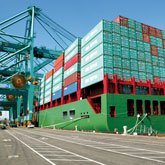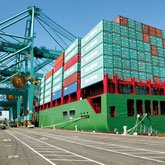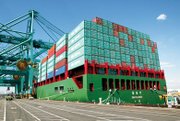Shippers Weighing East Coast Versus West Coast Ports
Looming labor problems shaping up at East and Gulf Coast ports this fall have apparel makers, retailers and other shippers scratching their heads and wondering whether they should send their holiday shipments to the West Coast.
Contract negotiations between the International Longshoremen’s Association and the United States Maritime Alliance—which represents East Coast shipping lines, terminal operators and 14 ports—got underway in March for a contract that expires Sept. 30.
But even before the negotiations took place in Tampa, Fla., there was clamoring from labor leaders that any push to incorporate major automation overhauls on the waterfront will not be welcome if it results in an erosion in jobs.
That was made clear in early March when a crusty Harold Daggett, ILA’s president, addressed more than 1,800 shipping and transportation-industry executives at the Trans-Pacific Maritime Conference in Long Beach, Calif.
He fired a warning shot by saying automation was going to be the toughest part of the contract to negotiate. “The legendary Teddy Gleason [a previous ILA president] negotiated contracts that allowed automation to flourish, but he always protected the jobs and livelihoods of every ILA member. I intend to do the same,” he said.
Automation has always been one of the stickiest points to tackle when longshore contracts are up for renewal. In 2002, when the West Coast’s International Longshore and Warehouse Union was negotiating its contract, automation was one of the topics that stalled talks and led to a lockout that closed West Coast ports for 10 days in October. Many apparel shippers lost millions of dollars because of late deliveries to retailers.
No one wants to see the same thing happen on the East Coast, but everyone is taking a cautious attitude and weighing their options even though the East Coast ports haven’t had a strike for 35 years.
“There have been rumblings about diverting cargo,” said Vincent Salvo, co-president of Carmichael International Service, a Los Angeles freight forwarder and customs broker that has many apparel clients.
None of his clients, he said, have finalized plans about rerouting their cargo to the West Coast, but “people are talking about it. We are keeping people abreast of what happens on the East Coast.”
Tim Simpson, a spokesperson for Maersk Line, one of the largest cargo-container shipping lines in the world, said he thought the situation was very fluid right now. But people shipping from Asia to the United States might start making more-concrete plans in August. “Usually, the booking cycle is six weeks out,” he said, noting August would probably be the earliest shippers would decide what to do.
Robert Krieger, head of Krieger Worldwide Inc., said now is the time to start making a contingency plan. “If you import into the East Coast, you should be looking at diversifying a bit,” he advised.
Port officials said they don’t have to make any contingency plans to accommodate new volumes because they are so far off their peak days in 2006 and 2007. “If we get extra business, we don’t have to prepare because we can use any extra business,” said Port of Long Beach spokesperson Art Wong.
In 2011, cargo-container volumes at the Port of Long Beach dipped slightly to 6 million 20-foot containers. At the Port of Los Angeles, cargo volumes in 2011 rose slightly to 7.9 million 20-foot containers. The all-time high for the Port of Los Angeles was in 2006, when 8.5 million containers passed through the docks.
“We are definitely keeping our ear to the ground and always looking for opportunities. Anyone who wants to come through here, we want to help them do that,” said Port of Los Angeles spokesperson Phillip Sanfield. “But we haven’t seen any indications of that materializing yet.”
Ironically, the Port of Los Angeles recently reported that this April was the best April on record for cargo-container volumes—707,182 containers, a 14.5 percent jump over last year.
At first glance, it would appear that shippers already are diverting cargo with such increased volumes. But Sanfield said port officials attribute the brisk traffic to growing consumer confidence in the economy and shipping-rate hikes that take effect in May.
Port executives may be optimistic about a cargo windfall this autumn, but West Coast longshore workers could dampen that spirit.
In early May, ILWU President Bob McEllrath stated that West Coast dock workers would stand in solidarity with their East Coast brethren when it comes to protecting job jurisdiction as employers introduce new automated cargo-handling equipment.
“No one should listen to the recent hum of industry executives suggesting they know what dockworkers on the West Coast will or won’t do in support of our East Coast brothers and sisters,” he said in a press release. “The fact is that we have their back in the fight to protect work and jurisdiction. Their fight is our fight.”
ILWU spokesperson Craig Merrilees would not say whether standing in solidarity meant a work stoppage at the West Coast ports. He merely said, “They are going to do what they need to do.”

























